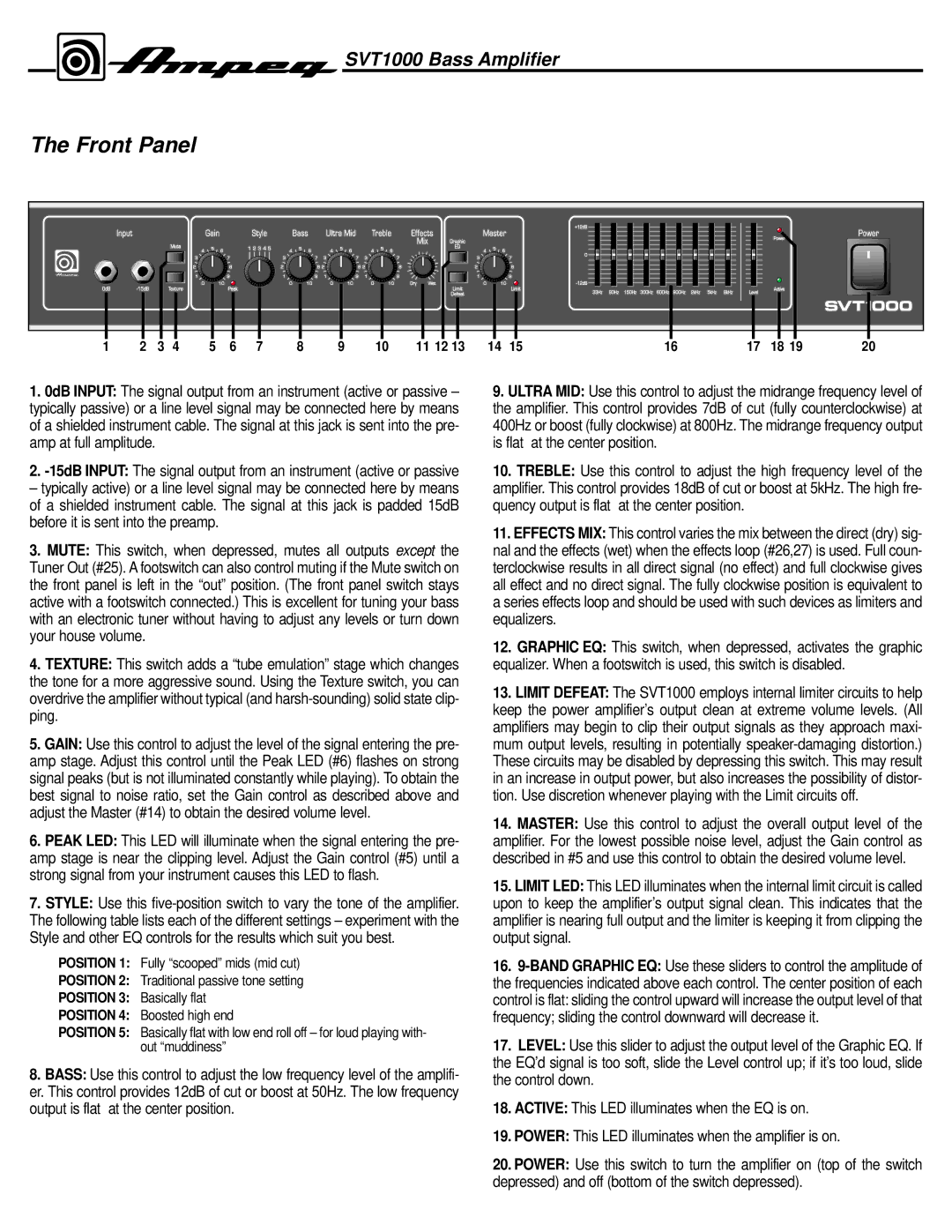
SVT1000 Bass Amplifier
The Front Panel
Input
Mute
0dB | Texture |
Gain
4 | 5 | 6 |
3 |
| 7 |
2 |
| 8 |
1 |
| 9 |
0 |
| 10 |
Peak
Style | Bass | Ultra Mid | Treble |
1 | 2 3 4 5 | 4 | 5 | 6 |
| 4 | 5 | 6 |
| 4 | 5 | 6 |
|
| 3 |
| 7 | 3 |
|
| 7 | 3 |
|
| 7 |
|
| 2 |
| 8 2 |
|
| 8 2 |
|
| 8 | ||
|
| 1 |
| 9 | 1 |
|
| 9 | 1 |
|
| 9 |
|
| 0 |
| 10 |
| 0 |
| 10 |
| 0 |
| 10 |
Effects
Mix Graphic
EQ
Dry | Wet |
Limit
Defeat
Master
4 | 5 | 6 |
3 |
| 7 |
2 |
| 8 |
1 |
| 9 |
0 |
| 10 |
Limit
+12dB |
|
|
|
|
|
|
|
| Power |
|
|
|
|
|
|
|
|
| |
|
|
|
|
|
|
|
|
| Power |
0 |
|
|
|
|
|
|
|
|
|
|
|
|
|
|
|
|
|
| |
33Hz | 80Hz | 150Hz | 300Hz | 600Hz | 900Hz | 2kHz | 5kHz | 8kHz | Active |
Level |
1 | 2 | 3 | 4 | 5 | 6 | 7 | 8 | 9 | 10 | 11 12 13 | 14 | 15 | 16 | 17 | 18 19 | 20 |
1.0dB INPUT: The signal output from an instrument (active or passive – typically passive) or a line level signal may be connected here by means of a shielded instrument cable. The signal at this jack is sent into the pre- amp at full amplitude.
2.
– typically active) or a line level signal may be connected here by means of a shielded instrument cable. The signal at this jack is padded 15dB before it is sent into the preamp.
3.MUTE: This switch, when depressed, mutes all outputs except the Tuner Out (#25). A footswitch can also control muting if the Mute switch on the front panel is left in the “out” position. (The front panel switch stays active with a footswitch connected.) This is excellent for tuning your bass with an electronic tuner without having to adjust any levels or turn down your house volume.
4.TEXTURE: This switch adds a “tube emulation” stage which changes the tone for a more aggressive sound. Using the Texture switch, you can overdrive the amplifier without typical (and
5.GAIN: Use this control to adjust the level of the signal entering the pre- amp stage. Adjust this control until the Peak LED (#6) flashes on strong signal peaks (but is not illuminated constantly while playing). To obtain the best signal to noise ratio, set the Gain control as described above and adjust the Master (#14) to obtain the desired volume level.
6.PEAK LED: This LED will illuminate when the signal entering the pre- amp stage is near the clipping level. Adjust the Gain control (#5) until a strong signal from your instrument causes this LED to flash.
7.STYLE: Use this
POSITION 1: Fully “scooped” mids (mid cut)
POSITION 2: Traditional passive tone setting
POSITION 3: Basically flat
POSITION 4: Boosted high end
POSITION 5: Basically flat with low end roll off – for loud playing with- out “muddiness”
8.BASS: Use this control to adjust the low frequency level of the amplifi- er. This control provides 12dB of cut or boost at 50Hz. The low frequency output is flat at the center position.
9.ULTRA MID: Use this control to adjust the midrange frequency level of the amplifier. This control provides 7dB of cut (fully counterclockwise) at 400Hz or boost (fully clockwise) at 800Hz. The midrange frequency output is flat at the center position.
10.TREBLE: Use this control to adjust the high frequency level of the amplifier. This control provides 18dB of cut or boost at 5kHz. The high fre- quency output is flat at the center position.
11.EFFECTS MIX: This control varies the mix between the direct (dry) sig- nal and the effects (wet) when the effects loop (#26,27) is used. Full coun- terclockwise results in all direct signal (no effect) and full clockwise gives all effect and no direct signal. The fully clockwise position is equivalent to a series effects loop and should be used with such devices as limiters and equalizers.
12.GRAPHIC EQ: This switch, when depressed, activates the graphic equalizer. When a footswitch is used, this switch is disabled.
13.LIMIT DEFEAT: The SVT1000 employs internal limiter circuits to help keep the power amplifier’s output clean at extreme volume levels. (All amplifiers may begin to clip their output signals as they approach maxi- mum output levels, resulting in potentially
14.MASTER: Use this control to adjust the overall output level of the amplifier. For the lowest possible noise level, adjust the Gain control as described in #5 and use this control to obtain the desired volume level.
15.LIMIT LED: This LED illuminates when the internal limit circuit is called upon to keep the amplifier’s output signal clean. This indicates that the amplifier is nearing full output and the limiter is keeping it from clipping the output signal.
16.
17.LEVEL: Use this slider to adjust the output level of the Graphic EQ. If the EQ’d signal is too soft, slide the Level control up; if it’s too loud, slide the control down.
18.ACTIVE: This LED illuminates when the EQ is on.
19.POWER: This LED illuminates when the amplifier is on.
20.POWER: Use this switch to turn the amplifier on (top of the switch depressed) and off (bottom of the switch depressed).
